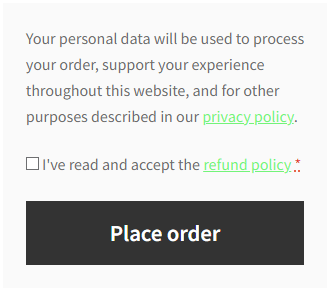Returns of goods are an indispensable part of any online store. As many customers as many reasons why a product can be returned so it's a good idea to equip your WooCommerce store with a return policy. The policy that includes the most important information a buyer looks for before making a WooCommerce return or refund.
Contents
- Why should you have a WooCommerce return policy?
- What is worth including in a return policy?
- Good practices when writing a refund policy
- Return policy and sales
- Returns in WooCommerce
- Customer acceptance of return policy in WooCommerce
- Where do I get a WooCommerce return policy from?
- WooCommerce refunds even more flexible!
- How to set your WooCommerce refund and return system (with a free plugin)
- How to handle returns and warranty requests in your WooCommerce store (with a free plugin)?
- Add your own refund form in a WooCommerce store [🤫Free plugin inside]
- How to make a full and partial refund in WooCommerce?
Why should you have a WooCommerce return policy?
A return policy saves time that you would normally have to spend on informing the customer about the terms of return. Having one will make it easier for the user to search for information. Well-written and well-considered refund policy will save a lot of hassle and problems when returning products in your WooCommerce store.
There are also three free plugins you can use to:
Add the refund policy checkbox at WooCommerce checkout

You may add such a checkbox with Flexible Checkout Fields or with a code snippet ⬇️
Let customers send refund requests in WooCommerce
What is worth including in a return policy?
When writing a return policy, it is worth including as much information as possible that is potentially important to each customer. Writing out on a piece of paper the path a buyer has to go through during a return process will certainly help.
Let me point here to a few examples worth mentioning:
- The time the customer has to make the return,
- The conditions for accepting the return,
- The return path (what the user must do to receive a refund)
- Refund payment method,
- Costs of return,
- The shipping method of returning the goods,
- The address to which the goods are to be shipped,
- Information on which products can be returned
Good practices when writing a refund policy
When composing a refund policy, it is worth remembering that the information drawn from it will be mainly for ordinary people so the language should be simple. Make sure that the policy contains as little "legal" language as possible, so that it can be understood by the average audience. This will avoid situations arising from a misunderstanding of some phrases written in the policy.
Return policy and sales
A properly structured returns policy can lead to increased sales. Yes, that's right! Customers seeing that the store they shop at presents a pro-consumer attitude are more likely to return to such a store.
According to data from IMRG's Returns Review 2020 report, 69% of customers check the return policy even before buying products in the store, and as many as 92% of customers who have gone through a well-executed return make purchases again.
What can be done to make return policies more pro-consumer?
- In a return policy, one may be tempted to present customers with more favorable conditions than those guaranteed by law, such as increasing the time to make a return from 14 to 30 days or reducing the time to return funds from 14 to 7 days.
- Free returns will also be perceived as working in favor of the consumer, and such information included in the return policy will surely please many customers.
- Making the return process easier for the customer by providing an online form for returns, instead of the standard email and paper versions. The WooCommerce Refunds plugin we offer gives the customer easy access to the return form saving time for both sides.
Returns in WooCommerce
WooCommerce creates a returns policy page by default, which you can freely edit according to your needs. It also has a built-in mechanism for returns. This one, however, may not be well enough suited to the needs of different stores and customers. We come to the rescue with the Flexible Refund plugin, which is used to expand the possibilities of customer returns.
Flexible Refund and Return Order for WooCommerce adds a form so that the customer can easily request the return of goods without having to write an email. The return itself can be done by refunding the appropriate amount to the customer's account or generating a discount code for further purchases in the store 😊. Visit the plugin's page!
Customer acceptance of return policy in WooCommerce
The user must read both the return policy and the terms and conditions of the online store before placing and paying for an order.
One of the most common solutions is to add a checkbox on the order page, which is required to be checked to place an order in the store. In WooCommerce, there are several ways to add such a checkbox.

Flexible Checkout Fields
Using Flexible Checkout Fields for WooCommerce, you only need to spend a few minutes configuring the plugin. It will easily add a checkbox to the order page and force you to check it before continuing.

Edit functions.php
If you don't want to use other plugins, you can add code to the functions.php file that will display a checkbox on the order page, which the user will have to check to continue ordering. Using this solution you will have full control over the checkbox, but it requires programming knowledge. We have prepared a simple script for you that will display a checkbox on the order page to accept the WooCommerce refund policy.
add_action( 'woocommerce_review_order_before_submit', function () {
woocommerce_form_field( 'refund_policy', array(
'type' => 'checkbox',
'required' => true,
'label' => 'I've read and accept the refund policy',
));
} );
add_action( 'woocommerce_checkout_process', function() {
if ( !isset( $_POST['refund_policy'] ) ) wc_add_notice( __( 'Please acknowledge the refund policy' ), 'error' );
} );
Where do I get a WooCommerce return policy from?
You can write a refund policy by hand using the tips I mentioned in the previous section of this article. You can also use the many refund policy generators available. After filling in some required data, they will generate a return policy you may use in WooCommerce.
One such generator is Termify. Once generated, all you have to do is paste the text into the appropriate page of your online store.
As you can see, having a refund policy in your WooCommerce store is important not only for legal reasons. Increasing sales or saving time are certainly worth taking a moment to compose a good WooCommerce return policy.






